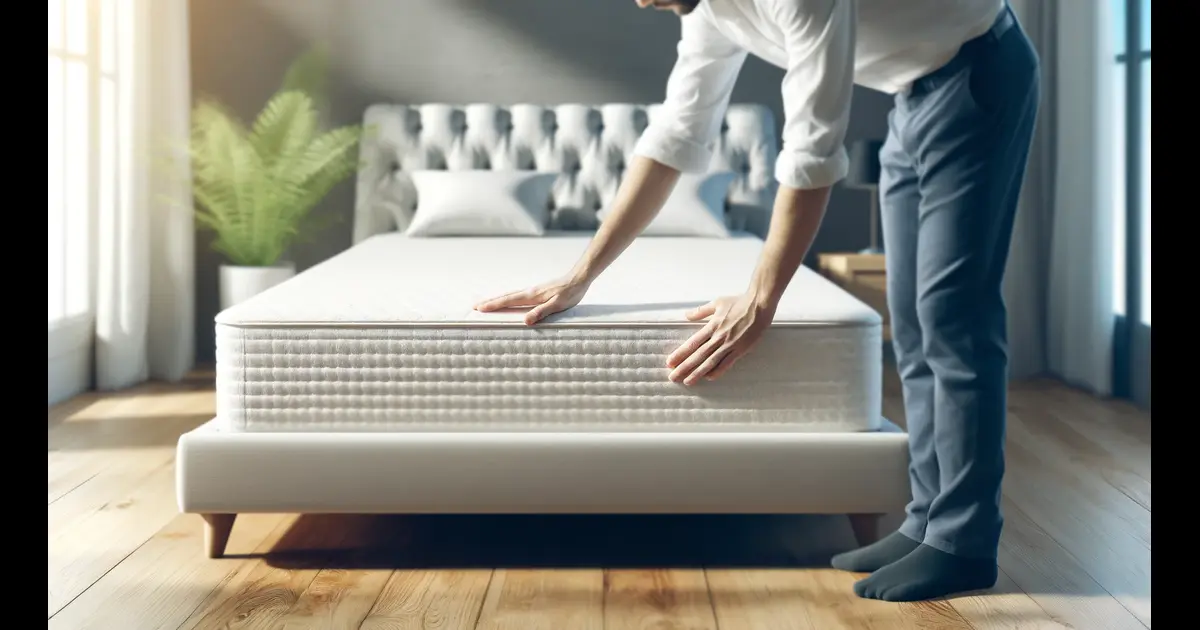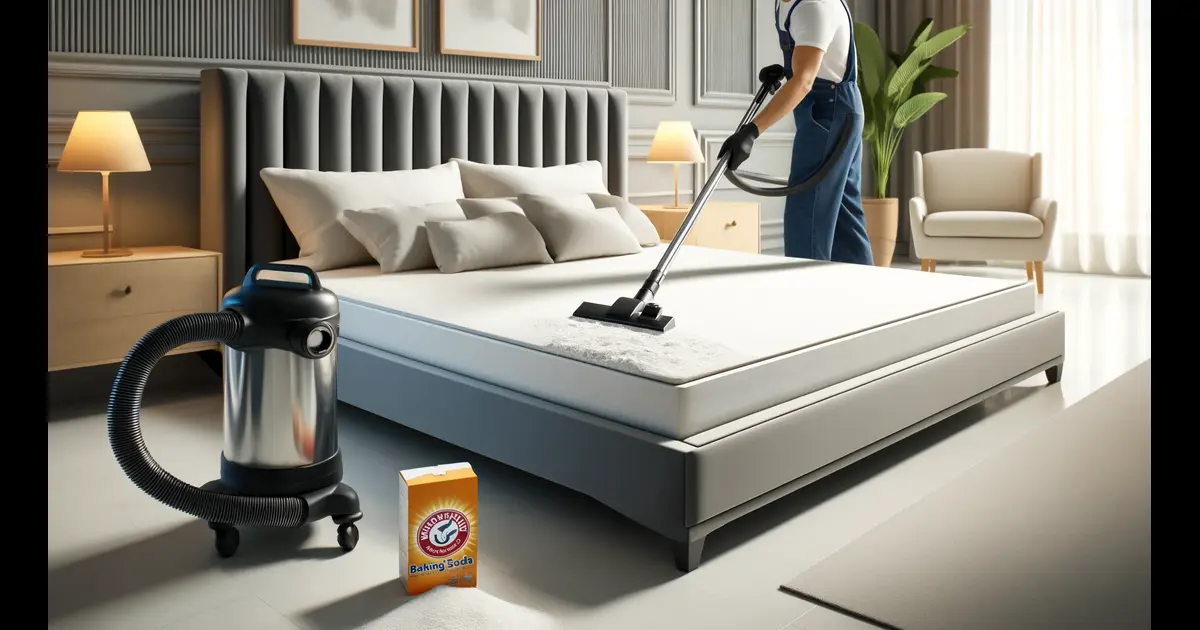Expert Endorsed Foam Mattress Care Tips: Extend Your Bed’s Life

Getting the most out of your foam mattress requires knowing the right care tips. These tips can make all the difference. Foam mattresses are a significant investment in your sleep quality. Proper maintenance can offer unparalleled comfort for many years.
This guide on foam mattress care tips will help you keep your mattress in top shape. It ensures your mattress provides the support and comfort you need. Following these tips will prolong its lifespan.
Regular cleaning is crucial. Make it a habit to vacuum your mattress weekly to remove dust and allergens. For those inevitable spills, address them immediately with spot cleaning to prevent stains from setting in. Deep cleaning should be done periodically to maintain overall hygiene and freshness.
Protective measures can significantly extend the life of your mattress. Using a mattress protector can shield it from spills, sweat, and other contaminants. Additionally, rotating your mattress every three to six months helps prevent uneven wear and sagging, keeping it in optimal condition.
Maintaining the right environment is also important. Foam mattresses thrive in cool, dry conditions. Avoid exposing them to direct sunlight or high humidity, as these can degrade the foam over time. Using a dehumidifier can help maintain the ideal moisture level in your bedroom.
You can make sure your mattress stays cozy and supportive for many restful nights by following these foam mattress care tips. Taking these steps not only enhances your sleep quality but also maximizes the value of your investment.

Understanding Your Foam Mattress
When it comes to understanding your foam mattress, it’s essential to know the different types available and their unique benefits. Foam mattresses come in various forms, including memory foam, latex, and hybrids, each offering distinct advantages and considerations.
Memory foam mattresses are known for their exceptional contouring abilities, providing pressure relief by molding to your body’s shape. This makes them ideal for side sleepers and those with joint pain. However, they can retain heat. This feature makes them less suitable for hot sleepers. They need to include cooling features like gel or graphite infusions.
Latex mattresses offer a more responsive and cooler sleeping surface compared to memory foam. They come in two types: natural and synthetic. Natural latex is more durable and hypoallergenic, providing a bouncy feel without the “sinking” sensation of memory foam. This type is excellent for those who sleep hot and prefer a more eco-friendly option.
Hybrid mattresses combine the benefits of both foam and innerspring mattresses. They have a supportive coil system. Foam or latex layers are placed on top. This setup provides a balanced mix of support, bounce, and pressure relief. Hybrids are great for those who want the best of both worlds. They tend to sleep cooler than all-foam models because of better airflow through the coils.
Understanding these types can help you make an informed decision based on your specific needs and preferences. You may value the contouring comfort of memory foam. Perhaps you prefer the cooling responsiveness of latex.
Or you might like the balanced support of hybrids. There’s a foam mattress out there to enhance your sleep quality and overall comfort.
Regular Cleaning Routine
Keeping your foam mattress clean is essential for maintaining its comfort and longevity. A well-maintained mattress not only enhances your sleep quality but also helps in reducing allergens and bacteria.
Here’s a detailed guide to help you establish a regular cleaning routine for your foam mattress. Focus on weekly vacuuming, spot cleaning, and deep cleaning techniques.
Weekly Vacuuming: Keeping Dust and Allergens at Bay
Vacuuming your foam mattress weekly is crucial. It helps remove dust, pet dander, and other allergens that accumulate over time. Use a handheld vacuum with a brush attachment to gently go over the entire surface of the mattress.
Make sure to get into the crevices and along the edges where debris can build up. This routine keeps your mattress clean. It also extends its lifespan by preventing dust mites and other allergens from settling in.
Spot Cleaning: Tackling Stains Before They Set
Accidents happen, and when they do, it’s important to tackle stains immediately to prevent them from setting. For fresh stains, blot the area with a clean, white towel to absorb as much liquid as possible. Avoid rubbing, as this can push the stain deeper into the foam.
Once the initial liquid is blotted, lightly mist the area with water and blot again until the stain is gone. For stubborn stains, a mixture of mild dish soap and water can be used. Remember, using cold water for blood stains is essential to avoid setting the stain further.
Deep Cleaning: When and How to Do It Right
Deep cleaning of your mattress should be done every three to six months to ensure it remains fresh and hygienic. Sprinkle a generous amount of baking soda over the mattress surface. Let it sit for several hours or even overnight.
Baking soda helps absorb odors and moisture. Afterward, vacuum the baking soda thoroughly. For deep-set stains, a mixture of vinegar and water or a mild detergent can be used.
Lightly mist the mattress with your cleaning solution and gently blot with a clean cloth. Ensure the mattress is completely dry before putting on any bedding to prevent mold and mildew.
Incorporate these cleaning practices into your routine. You will significantly extend the life of your foam mattress. This helps to maintain a healthy sleeping environment. Regular maintenance preserves the mattress’s integrity. It also ensures a better night’s sleep free from allergens and unpleasant odors.

Protective Measures for Your Mattress
Protecting your foam mattress can make a significant difference in its longevity. You need to implement the right measures.
Here’s a comprehensive guide to the essential protective steps for your mattress. It covers the importance of a mattress protector. You will also learn about choosing the right bed frame, and the necessity of rotating and flipping your mattress.
The Importance of a Mattress Protector
A mattress protector is a critical first line of defense for your mattress. It helps shield your bed from spills, stains, dust mites, and allergens, which can degrade the mattress material over time.
Most mattress protectors are waterproof. They ensure that any accidental spills do not seep into the mattress. This prevents mold or mildew from developing. Additionally, they can be easily removed and washed, maintaining a clean and healthy sleep environment.
Choosing the Right Bed Frame: Ensuring Proper Support
Selecting the right bed frame is crucial for providing the necessary support for your foam mattress. A well-supported mattress prevents sagging and extends its lifespan. Look for a bed frame that matches the size of your mattress and offers sturdy, even support.
Slatted bed frames are a popular choice. However, make sure the slats are not too far apart. Wide gaps can cause the mattress to sag. Additionally, consider frames with center support beams for larger mattresses to prevent any middle sagging.
Rotating and Flipping: How Often and Why It’s Necessary
Rotating and flipping your mattress regularly helps to distribute wear evenly, preventing depressions and sagging in specific areas. For most foam mattresses, rotating them 180 degrees every three to six months is recommended.
This practice ensures that the mattress wears evenly, maintaining its comfort and support over time. Many modern foam mattresses are designed to be one-sided. They do not require flipping. Flippable mattresses should be flipped on the same schedule as rotating to maximize their lifespan.
By following these protective measures, you can significantly extend the life of your foam mattress. This will ensure it remains comfortable and supportive for many years. Implementing these simple steps will not only protect your investment but also enhance your overall sleep quality.

Dealing with Spills and Accidents
Dealing with spills and accidents on your mattress promptly is crucial to maintaining its longevity and hygiene. Here’s a comprehensive guide to handling these mishaps effectively, from immediate actions to cleaning solutions and mold prevention.
Immediate Steps to Take After a Spill
When a spill occurs, quick action is essential to prevent moisture from seeping deep into the mattress. Start by removing all bedding. Use absorbent towels to blot the spill. Avoid any rubbing that could push the liquid further in.
Use a handheld vacuum or a wet/dry vacuum to extract as much moisture as possible. Sprinkle baking soda over the wet area to absorb remaining moisture and odors. Let it sit for several hours. Then vacuum it up again. Ensure the mattress is placed in a well-ventilated area and use fans or a dehumidifier to expedite drying.
Best Cleaning Solutions for Different Types of Stains
Different stains require specific cleaning solutions to effectively remove them without damaging the mattress.
Preventing Mold and Mildew Growth
Preventing mold and mildew is critical as they can cause health issues and irreparable damage to the mattress. Here are some tips:
By following these steps, you can effectively manage spills and accidents. This will keep your mattress clean. It will also keep it fresh and in good condition for years to come.
Temperature and Humidity Control
Keeping the right temperature in your bedroom is important. You should also maintain appropriate humidity levels. This is essential for the longevity and performance of your foam mattress. Here’s a detailed guide on how to manage these factors effectively, ensuring your foam mattress remains comfortable and durable.
Ideal Room Conditions for Foam Mattresses
Foam mattresses are sensitive to their environment, particularly temperature and humidity. The optimal temperature for a bedroom with a foam mattress is around 65 degrees Fahrenheit.
This temperature aligns with the natural drop in body temperature during sleep, helping to maintain comfort and prevent overheating. Humidity levels should ideally be between 30% and 50% but never exceed 60%.
Excessive humidity can lead to mold and mildew, while too little can cause the mattress material to become brittle.
Using Dehumidifiers and Air Purifiers
Dehumidifiers and air purifiers can be instrumental in maintaining the right environment for your foam mattress. A dehumidifier helps to reduce excess moisture in the air, which is particularly useful in humid climates or seasons.
When choosing a dehumidifier, look for models that operate efficiently within the temperature range of 60 to 85 degrees Fahrenheit. Some advanced models even work in lower temperatures but may require more maintenance and energy.
Air purifiers help remove allergens, dust, and other particulates from the air. These particulates can settle into your mattress and affect your sleep quality. Combining these two devices can create a healthier, more comfortable sleeping environment by managing both humidity and air quality effectively.
Seasonal Care Tips: Adapting to Weather Changes
Seasonal changes can significantly impact the conditions of your bedroom. Here are some tips to adapt to different weather conditions:
By carefully managing temperature and humidity in your bedroom, you ensure your foam mattress stays comfortable. This supportive sleep surface will last for years to come. Regular maintenance of your dehumidifier and air purifier is essential. It helps keep your sleep environment optimal. It also keeps your mattress in peak condition and manages sagging.

Preventing and Managing Sagging
Mattress sagging is a common issue that can affect your sleep quality and comfort over time. To keep your mattress supportive, recognize early signs of sagging. Implement solutions to minimize it. Here’s a comprehensive guide to help you prevent and manage mattress sagging effectively.
Identifying Early Signs of Sagging
Spotting early signs of sagging can help you address the issue before it becomes severe. Look for:
By regularly inspecting your mattress, you can catch these signs early and take corrective action.
Solutions to Minimize Sagging Over Time
Preventing and minimizing sagging involves a few key practices:
When to Consider Mattress Toppers or Replacements
If your mattress has minor sagging, a mattress topper can be a cost-effective way to extend its life. However, for more significant sagging, replacement might be necessary. Here are indicators that it’s time for a new mattress:
Understand these signs. Take proactive steps. Then, you can ensure your mattress provides the support and comfort you need for a restful night’s sleep.

Proper Handling and Moving
Moving a foam mattress can be challenging because of its size and flexibility. However, with the right steps, you can ensure it stays in great condition. Here’s how to handle and move your foam mattress properly. We include dos and don’ts. We also provide storage tips and common mistakes to avoid.
Safely Moving Your Foam Mattress: Dos and Don’ts
Dos:
Don’ts:
Storing Your Mattress: Short-Term and Long-Term Tips
Short-Term Storage:
Long-Term Storage:
Avoiding Common Mistakes During Transportation
By following these tips, you can move and store your foam mattress safely, preserving its comfort and lifespan. Remember, taking a little extra care during the move can save you from costly damages and ensure your mattress remains in excellent condition for years to come.
Allergy and Health Considerations
Maintaining a healthy sleep environment is crucial, especially for those with allergies or chronic pain. Here’s how you can reduce allergens, ensure optimal comfort, and maintain hygiene with your foam mattress.
Reducing Allergen Exposure: Tips for Allergy Sufferers
Allergens such as dust mites, mold, and pet dander can accumulate in your mattress, exacerbating allergy symptoms. Here are some practical tips to minimize exposure:
Foam Mattress and Back Pain: Ensuring Optimal Comfort
A foam mattress can benefit back pain, but it can also cause problems. This depends on its quality and how you use it. Here’s how to ensure it provides the best support:
Maintaining Hygiene: Importance of Regular Bedding Changes
Keeping your bedding clean is essential for both health and comfort. Here’s how to maintain hygiene effectively:
By following these steps, you can create a healthier sleep environment. You can reduce allergy symptoms. Ensure your foam mattress supports your back effectively. This contributes to a better night’s sleep.

Enhancing Mattress Comfort and Performance
Creating a comfortable and supportive sleep environment goes beyond just having a good mattress. Here’s how to enhance your mattress comfort and performance effectively.
Using Pillows and Cushions Effectively
Pillows play a crucial role in supporting your body and maintaining proper alignment during sleep.
Here are some key tips:
Choosing the Right Bedding Materials
The materials of your bedding can significantly impact your comfort and sleep quality. Consider the following:
Enhancing Sleep Quality: Tips for a Better Night’s Rest
To maximize the benefits of your mattress and pillows, follow these additional tips for better sleep quality:
Focusing on these elements, you can create a sleep environment that not only enhances the comfort and performance of your mattress but also promotes a healthier and more restful night’s sleep.
Extending the Lifespan of Your Mattress
Ensuring your mattress lasts as long as possible requires proper care and maintenance. Here’s how you can recognize when it’s time for a replacement, explore eco-friendly disposal and recycling options, and understand why investing in quality pays off in the long run.
Recognizing When It’s Time for Replacement
Knowing when to replace your mattress is key to maintaining good sleep quality. Look for these signs:
Eco-Friendly Disposal and Recycling Options
Disposing of your old mattress responsibly helps reduce environmental impact. Here are some options:
Investing in Quality: How It Pays Off in the Long Run
Investing in a high-quality mattress may have a higher upfront cost, but it offers several long-term benefits:
Recognizing the signs that it’s time to replace your mattress, choosing eco-friendly disposal methods, and investing in a high-quality product, you can enjoy better sleep and contribute to a healthier environment.
Final Takeaway: Foam Mattress Care Tips
Proper mattress care can significantly extend its lifespan and enhance your sleep quality. Recognize when it’s time for a replacement by looking for signs like back pain and visible wear. Opt for eco-friendly disposal methods like donating or recycling.
Investing in a high-quality mattress pays off with better durability and health benefits. Remember to use supportive pillows. Choose breathable and hypoallergenic bedding materials. Maintain a clean sleep environment to maximize comfort and performance.
By following these guidelines, you ensure a healthier, more restful night’s sleep for years to come.

Yanie Wijaya
CFO @ wijayafoam.com
Yanie Wijaya is a leading expert in the foam mattress industry with over 15 years of experience. As the owner of Wijaya Foam and key brands like Asia Deluxe and Eversoft Rebonded, she has shaped mattress manufacturing across Southeast Asia. Outside of her professional life, Yanie enjoys motherhood and Korean cinema. Her deep industry knowledge makes her a trusted authority in foam mattress innovation.

